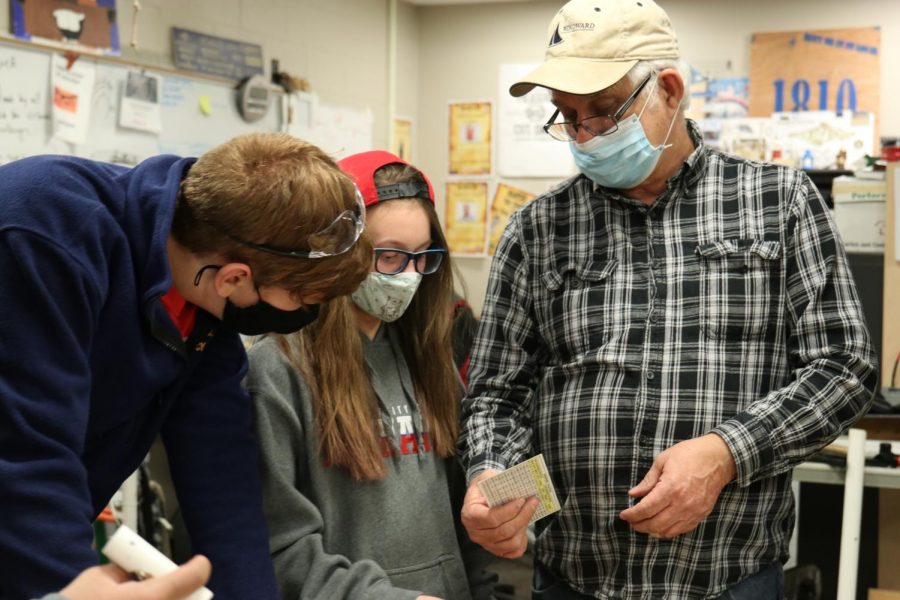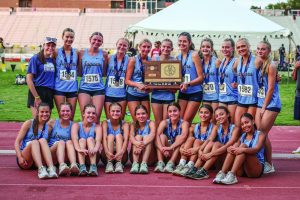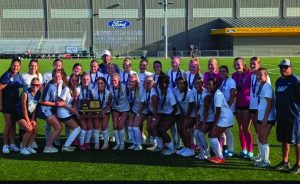Robotics returns to in-person meetings
After a time of virtual robotics, the team is once again meeting and building in-person
February 23, 2021
Much like many other teams in the time of both the pandemic and remote learning, robotics was virtual—and quite different—for a time. Now that school is fully back in-person, robotics is meeting together once again—but with new changes and challenges, of course.
“In robotics right now, we are working in person with masks, of course, but at the start robotics was cancelled,” senior Kyle Mayfield, a member of the robotics group, said. “Later, for a while, we met online over Zoom; during that time, we had small groups come in, but as of now we meet in-person two to three times a week and usually also meet online once a week.”
“For all of first semester, the robotics team was split into two groups,” senior Courtney Mahugu, a member of the robotics team, said. “The first group was the mechanical engineering kids and the marketing kids, the second group was the programming and electrical engineering kids.”
Junior Ryan Layton, also a member of the robotics team, reflects upon the new differences and similarities too.
“Robotics over this last year has seen a lot of changes. Last year our season was canceled and then we met remotely for a few weeks. Currently we are meeting in person as normal and working as usual with masks,” he said.
Though they realizes the challenges that come with modifying the already challenging field of robotics, Mahugu, Mayfield and Layton believe that these new changes for 2021 are both positive and negative; though finding it sad that the robotics competition season was cut short due to COVID-19, Mayfield finds the silver lining within being able to meet the team in-person.
“We are able to work more cohesively with each other on design and planning out the robot because we usually get to meet more than 3 times per week,” Mayfield said. “Last year we went to Lee’s Summit North for a competition; we were planning on going to another later, but due to COVID-19 we couldn’t go to it. I enjoy working with the team; it’s great to use critical thinking skills and also learn new skills and ways of doing things. It’s fun to be on the team. I enjoy it and many others do too.”
Layton explains how the competitions are working this year.
“Usually we would travel to regional and compete with teams from all over the area. This year we are completing challenges and tasks with our robot from home. These challenges range from navigating a course to display driver skill or shooting balls for accuracy. All of these challenges will be recorded and then sent in for judging. Typically each year the team builds one robot. The purpose of the robot depends on the “game” that we are going to be playing and competing in for that year. The robot is relative in size to a snow blower or car engine.”
Mahugu also reflects upon the new nature of the competition.
“The competition is completely virtual this year. The competition is composed of aspects of last year’s robotics game split into 5 mini-games. Teams submit videos of their robot competing in these mini-games whether it be shooting balls at a target or showing off your robot’s driving abilities in the Tele-op (driving) mini-game. There are also two additional side challenges this year: the Innovation challenge and the Game Design challenge. In the innovation challenge, the team designs a product that can improve physical and/or mental health through movement. The team will then make a pitch, business model, and presentation to present to judges.
Mayfield also explains how the new robotics procedures have been working this year; much like normal, the team works together to build a robot to use in a competition once a year and work in three subgroups: electrical, programming, and mechanical. Though having some subtle changes, Mayfield enjoys being with the team.
“Normally we build from scratch each year, but this year we are allowed to modify the robot we used last year because of COVID-19. So, we redesigned how the robot picks up and shoots balls,” he said.
Despite all the new adjustments due to the pandemic, Mahugu, Layton and Mayfield still said that some of the changes were positive, and despite the lack of normal competitions in the time of COVID-19, they look forward to those in the future; all three teammates said that their favorite aspect of robotics was the competition aspect.
“My favorite part of robotics is the competition. Everything about competition day is fun. There are a bunch of chaotic nerds under one school building with loud music in the background and kids running around with robots,” Mahugu said. “The whole atmosphere is a vibe. You get to see all the creative robots people have made, come up with a few ideas for next year’s robot. I’ve seen a robot made of cardboard and it was impressive. You get a chance to meet everyone and while everyone is competitive, they are also super friendly because they know you could be paired as teammates for any match. The overall energy is hectic, chaotic, and super exciting.”
Layton also enjoys being back together with his teammates.
“Being able to solve problems is what drives the team forward and helps us learn and get better. This helps us build a better robot the next year based on what we learned in the past.”










